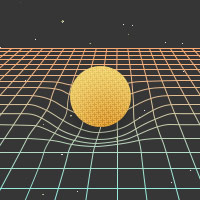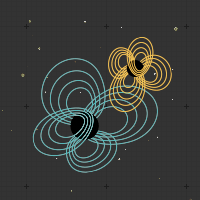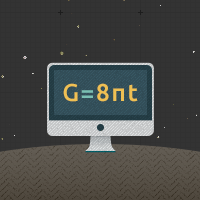Gravitational Lensing
 An interesting prediction of general relativity is that light does not just travel in a straight line, but its path is bent by gravity. Gravitational lensing is the name for the bending of light by gravity, as the source of gravity (e.g. a galaxy) acts as a physical lens which bends the light. There is ample observational evidence of these deflections of light by massive bodies, including measuring the deflection of starlight passing near the Sun. However, the largest observed deflection of light is only very slight, around 11 arc seconds or 0.003 degrees.
An interesting prediction of general relativity is that light does not just travel in a straight line, but its path is bent by gravity. Gravitational lensing is the name for the bending of light by gravity, as the source of gravity (e.g. a galaxy) acts as a physical lens which bends the light. There is ample observational evidence of these deflections of light by massive bodies, including measuring the deflection of starlight passing near the Sun. However, the largest observed deflection of light is only very slight, around 11 arc seconds or 0.003 degrees.
The SXS Lensing group is interested in much more eXtreme deflections of light. Near black holes, the most compact objects in the universe, light can be so strongly bent by gravity that it can orbit many times around the black hole before making it to your eye. In theory, there is no limit to the number of times a light ray can orbit the black hole. Even though black holes emit no light themselves, their effect on light passing nearby leads to some stunning visual and mathematical results!
Single black hole
 We have written code to produce images of stars from a star catalog, such as the 2MASS catalog. We take each star's location and its magnitude in different color bands from the catalog. To generate the image, we need to know from where light enters each pixel of the camera as well as the redshift of the light. More details are provided in our paper. This is an image showing the Milky Way using our star rendering code.
We have written code to produce images of stars from a star catalog, such as the 2MASS catalog. We take each star's location and its magnitude in different color bands from the catalog. To generate the image, we need to know from where light enters each pixel of the camera as well as the redshift of the light. More details are provided in our paper. This is an image showing the Milky Way using our star rendering code.
With our camera pointing in the same direction as the previous image, we now see how a black hole affects light from these stars. The first feature that pops out is a large circular shadow in the center of the image. This is called the shadow of the black hole, because it is a region where the black hole prevents light from reaching the camera, such that the black hole is casting a shadow on the image.
Near the borders of the image, light from the stars is slightly deflected. Notice the dark patches where there aren't many stars in the lower right portion of the original image. These appear to be located near the lower right corner of the image now, due to the gravity of the black hole. This is analogous to the light being deflected around the sun, making a star's apparent position somewhere else, as depicted earlier.
Light passing closer to the shadow is being deflected even more by the black hole. There is a large ring structure around the shadow called an Einstein ring. This is where light from directly on the opposite side of the black hole is deflected around the hole on its way to the camera. It makes a ring due to the symmetry, but we even see such a ring in cases where the black hole has spin. Roughly in the center of the original image, there is a bright blue star near an orange one. This is almost directly behind the black hole, so it is very close to the Einstein ring. You may have noticed that we can see two images of both of these stars, one at about 1:30 inside the Einstein ring, and one at about 7:30 on the outside of the ring. In fact, inside the Einstein ring, we can see an image of the rest of the galaxy! Light from behind the camera, for example, can take a path halfway around the black hole on the way to the camera.
Although it is hard to see, very close to the shadow there is a bright ring. This is actually the second Einstein ring, corresponding to light from directly behind the camera. In fact, there are an infinite number of these Einstein rings in theory, but we can only resolve two of them in this particular image.
Binary black hole
While lensing by a single black hole has been studied for quite a long time, no one had previously known what astrophysically interesting binary black holes would actually look like. The problem is complicated significantly by having to solve what happens to two black holes orbiting each other. The SXS collaboration uses the Spectral Einstein Code (SpEC) to simulate these kinds of compact object mergers, be it with black holes or neutron stars with high accuracy. With SpEC, the SXS Lensing group is in a unique position to explore what a binary black hole merger would look like.
In the following video, we see the last three orbits of a three to one mass ratio binary with arbitrarily chosen spins on both black holes. The details of this merger can be found in Taylor et al. as case 4. The stars used are the same as the ones used in the single black hole image above. The camera is located above the orbital plane of the binary looking down.
We see an Einstein ring surrounding both masses. This is not general, however. When the black holes are separated by a large distance spatially, we could see an Einstein ring around each black hole individually. Near both shadows we see a smaller shadow, which is called an eyebrow due to its shape. These secondary shadows correspond to one black hole casting a shadow which is lensed by the other black hole on the way to the camera. Our paper explores these smaller shadows in more detail, finding that there are in fact an infinite number of these shadows, but we can only resolve a few in this video.
After the merger, the shadows transition to a single shadow and the background deflections settle to a stationary state which looks like the lensing by a single black hole. This matches our expectations. After black holes have merged, there is a ringdown phase, where energy is radiated from the black hole until it settles to a stationary single black hole solution.
We have another viewpoint of this merger, shown below. The opening angles of the cameras were slightly different for this video, so we also provide what the background stars would look like with these new parameters.
In this video, the camera is essentially located in the orbital plane of the binary. This is what we call an "edge-on" view. As the black holes orbit, one black hole passes behind the other relative to the camera. As this happens, the shadow cast by the farther black hole is lensed by the closer black hole into a ring-like shadow. Additionally, we can see the effect that the arbitrary spins has on the orbit. The orbital plane precesses visibly in these last three orbits before merger. As before, we see that the lensing settles down to look like lensing by a single black hole.
We have some interesting brightness effects which are more apparent from this viewpoint than the previous video's viewpoint. Some photons passing through the binary system have accumulate non-unity redshift. The brightness is affected by the redshift by a factor of redshift cubed, so there is a large brightness change for only a small redshift difference. Overall, near the left side of the shadows we see the brightness damped significantly, while on the right side we see flashes of brightness!
Black holes at Cornell
While looking at black holes in front of a field of stars, it is easy to lose your bearings. In our paper, we frequently color sections of the sky with a grid to more easily understand the deflection of light by the black holes. A more fun way to accomplish this is by using a recognizable image. Instead of using stars, we therefore use a picture of the clock tower at Cornell.
Now we stick a black hole on campus, because we can and it's awesome. We can see clearly that near the edges of the image, the view of campus is only slightly changed. The image of the clock tower is bent slightly. However, inside the Einstein ring, we can see the size of the deflections grows. The image is also inverted. The clock tower here is on the left and is upside down, in addition to being even more bent. The grass is up and the sky is down inside the Einstein ring.
Now is a good time to remind you that light can be deflected all the way around the black hole. To properly see what a black hole on campus would look like, we need not only an image of what's in front of the camera, but also directly above and below the camera. Even light from directly behind the camera will get deflected around the black hole on its way to the camera! Light-rays can take paths which orbit many times around the black hole before reaching the camera, resulting in an infinite number of clock towers (if you had an infinite resolution camera to see them)!
If we can put one black hole on campus, why not two? This is the same binary discussed in the Binary black hole section. It is a three to one mass ratio binary. The same discussion of an infinite number of black hole shadows applies here as well.












